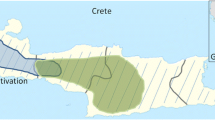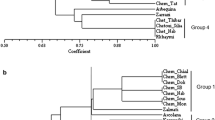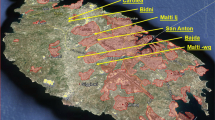Abstract
To assess the genetic diversity of the most important olive cultivars used in Portugal, a base collection was established with two hundred and one accessions of eleven cultivars from the different agro-ecological-regions (AER) of olive oil production. Inter-cultivar diversity was evaluated using seven RAPD primers producing fifty-nine polymorphic markers that enable cultivar distinction. Discriminant analysis according to fruit use and AER revealed a genetic structure associated with local selection both for fruit exploitation and agro-ecological adaptation. Intra-cultivar diversity of the ancient cultivar ‘Galega’ was also investigated. Three RAPD and five ISSR primers produced ninety-three polymorphic markers upon seventy-seven accessions from five AERs. Total accession discrimination was achieved. UPGMA clustering and discriminant analysis revealed that the genetic diversity was predominantly structured according to accessions origin. The within and among AER variation revealed by AMOVA supported this genetic structure and showed a high proportion of intra-AER variability. These evidences suggest that ‘Galega’ is composed by a mixture of different genotypes adapted to local conditions, indicating that this cultivar is in an early stage of domestication and should be treated as a landrace instead of a uniform cultivar. The assessment of ‘Galega’ genetic diversity within each of the five AERs indicated the highest significant level (Hg = 6.23 at p< 0.001) in “Ribatejo-Santarém”. This finding associated with the distinctiveness of ‘Galega’ in relation to other Portuguese cultivars and with the recent insights of olive tree domestication allowed us to hypothesize that ‘Ribatejo-Santarém’ was the ecological region of origin and dispersion of this ancient cultivar.
Similar content being viewed by others
References
Applied Maths 2000. Bionumerics Manual, version 2.0, Kortrijk, Belgium.
Belaj A., Trujillo L., de la Rosa R. and Rallo L. 2001. Polymorphism and discrimination capacity of RAPD markers in an olive germplasm bank. J. Amer. Soc. Hort. Sci. 126: 64–71.
Belaj A., Satovic Z., Rallo L. and Trujillo I. 2002. Genetic diversity and relationships in olive (Olea europaea L.) germplasm collec tions as determined by randomly amplified polymorphic DNA. Theor. Appl. Genet. 105: 638–644.
Besnard G. 1999. Étude de la diversité génétique de l'olivier cultivé et de ses formes sauvages apparentées à l'aide de marqueurs moléculaires: applications pour l'identification variétale et pour la gestion des ressources génétiques. These Université, Montpel lier II, 174 pages.
Besnard G., Baradat P. and Bervillé A. 2001a. Genetic relationships in the olive (Olea europaea L.) reflect multilocal selection of cultivars. Theor. Appl. Genet. 102: 251–258.
Besnard G., Breton C., Baradat P., Khadari B. and Bervillé A. 2001b. Cultivar identification in olive based on RAPD markers. J. Amer. Soc. Hort. Sci. 126: 668–675.
Besnard G., Khadari B., Baradat P. and Bervillé A. 2002. Olea europaea (Oleaceae) phylogeography based on chloroplast DNA polymorphism. Theor. Appl. Genet. 104: 1353–1361.
Bogani P., Cavalieri D., Pretuccelli R., Polsinelli L. and Roselli G. 1994. Identification of olive tree cultivar by using random amplified polymorphic DNA. Acta Hort. 356: 98–101.
Bronzini de Caraffa V., Maury J., Gambotti C., Breton C., Bervillé A. and Giannettini J. 2002. Mitochondrial DNA variation and RAPD mark oleasters, olive and feral olive from Western and Eastern Mediterranean. Theor. Appl. Genet. 104: 1209–1216.
Carriero F., Fontanazza G., Cellini F. and Giorio G. 2002. Identifi-cation of simple sequence repeats (SSRs) in olive (Olea europaea L.). Theor. Appl. Genet. 104: 301–307.
CIAP 2002. Centro de Informaçãoo do Azeite – Portugal (CIAP). http://www.infoazeite.net/prodcon/ producao.html.
Cipriani G., Marrazzo M.T., Marconi R. and Cimato A. 2002. Microsatellite markers isolated in olive (Olea europaea L.) are suitable for individual fingerprinting and reveal polymorphism within ancient cultivars. Theor. Appl. Genet. 104: 223–228.
Claros M.G., Crespillo R., Aguilar M.L. and Cánovas F.M. 2000. DNA fingerprinting and classification of geographically related genotypes of olive tree (Olea europaea L.). Euphytica 116: 131–142.
COI 2000. Catalogue Mondial des Varites d'Olivier, Conseil Oléicole International (COI), Madrid.
Contento A., Ceccarelli M., Gelati M.T., Maggini F., Baldoni L. and Cionini P.G. 2002. Diversity of Olea genotypes and the commerorigin of cultivated olives. Theor. Appl. Genet. 104: 1209–1216.
GDR 1997. Cadernos de Especificaç?es das Zonas com De-nominação de Origem Protegida, Direcção Geral do Desenvol-vimento Rural (DGDR).
Doyle.J. and Doyle L. 1990. Isolation of plant DNA from fresh tissue. Focus 12: 13–15.
Esselman E.J., Jianqiang L., Crawford D.J., Windusss J.L. and Wolfe A.D. 1999. Clonal diversity in the rare Calamagrosis porteri ssp. insperata (Poaceae). comparative results for al-lozymes and random amplified polymorphic DNA (RAPD) and intersimple sequence repeat (ISSR) markers. Mol. Ecol. 8: 443–451.
Gemas V.J.V., Rijo-Johansen M.J., Tenreiro R. and Fevereiro P. 2000. Inter and intra-varietal analysis of three Olea europaea L. cultivars using the RAPD technique. J. Hortic. Sci. & Biotech. 75: 312–319.
Gilbert J.E., Lewis R.V., Wilkinson M.J. and Caligari P.D.S. 1999. Developing an appropriate strategy to assess genetic variability in plant germplasm collections. Theor. Appl. Genet. 98: 1125–1131.
GPPAA 1997. Aspectos Gerais do Sector Oleícola em Portugal. Forum Nacional de Agricultura e de Desenvolvimento Rural, Santa Maria da Feira.
Hess J., Kadereit J.W. and Vargas P. 2000. The colonization history of Olea europaea L. in Macaronesia based on internal tran-scribed spacer 1 (ITS-1) sequences, randomly amplified poly-morphic DNAs (RAPD), and intersimple sequence repeats (ISSR). Mol. Ecol. 9: 857–867.
Hutcheson K. 1970. A test for comparing diversities based on the Shannon formula. J. Theoret. Biol. 29: 151–154.
Karp A., Kresovich S., Bhat K.V., Ayad W.G. and Hodgkin T. 1997. Molecular tools in plant genetic resources: a guide to the tech-nologies. IPGRI Technical Bulletin Number 2.
Leitão F. 2001. Valorização das cultivares de Olea europaea L. ‘Negrinha de Freixo’ (Denominação de Origem) e ‘santulhana’ em Trás-os-Montes Revista de Ciências. Agrarias 24: 43–51.
Leitão, F., Pontes, M. F., Calado, M. L. & Almeida, F. J., 1986. Descrição de 22 variedades de oliveira cultivadas em Portugal. Ministério da Agricultura, Pescas e Alimentação, Direcção Geral do Planeamento e Agricultura, Lisboa.
Lumaret R., Ouazzani N., Michaud H. and Villemur P. 1997. Cultivated olive and oleaster. two very closely connected part ners of the same species (Olea europaea) Evidence from enzyme polymorphism. Bocconea 7: 39–42.
MADRP, 1997. Plano para a Dinamização da Fileira Oleícola, Gabinete de Planeamento e Política Agro-Alimentar (GPPAA), Lisboa.
Martins A., Santos L., Lopes J. and Gouveia J. 1997. La sélection des variétiés anciennes d' olivier. Galega et Cobranc¸osa. Olivae 66: 46–49.
Mekuria G.T., Graham G.C. and Sedgley M. 1999. Genetic vari ability between different accessions of some common commer-cial olive cultivars. J. Hortic. Sci. Biotech. 74: 309–314.
Michael's S.C., John M.C. and Amasino R.M. 1994. Removal of polysaccharides from plant DNA by ethanol precipitation Biotechniques. 17: 274–276.
Ouazzani N., Lumaret R. and Villemur P. 1996. Genetic variation in the olive tree (Olea europaea L.) cultivated in Morocco Euphytica. 9–20.
Ouazzani N., Lumaret R., Villemur P. and Di Giusto F. 1993. Leaf allozyme variation in cultivated and wild olive tree (Olea europaea L.). J. Hered. 34–42.
Penner G.A. 1996. RAPD analysis of plant genomes. In: Jauhar P.P. (ed.), Methods of genome analysis in plants. CRC Press, Boca Raton, pp. 251–268.
Ribeiro O. 1991. Portugal, o Mediterrâneo e o Atlântico. Livraria Sá Costa Editora, Lisboa.
Sanz-Cortés F., Badenes M.L., Paz S., ?niguez A. and Ll?ácer G. 2001. Molecular characterization of olive cultivars using RAPD markers. J. Amer. Soc. Hort. Sci. 126: 7–12.
Schneider S., Roessli D. and Excoffier L. 2000. Arlequin version 2.000: A software for population genetic data analysis. Genetics and Biometry Laboratory. University of Geneva, 6Switzerland.
Sicard D., Woo S., Arroyo-Garcia R., Ochoa O., Nguyen D., Korol A. et al. 1999. Molecular diversity at the major cluster of disease resistance genes in cultivated and wild Lactuca spp. Theor. Appl. Genet. 405–418.
Silva G., Granchinho M. and Fernandes M.O. 1999. Análise da Fileira do Azeite Ingenium. 36: 79–85.
Vargas P. and Kadereit J.W. 2001. Molecular fingerprinting evi-dence (ISSR, Inter-Simple Sequence Repeats) for a wild status of Olea europaea L. (Oleaceae) in the Eurosiberian North of the Iberian Peninsula Flora. 196: 142–152.
Wiesman Z., Avidan N., Lavee S. and Quebedeaux B. 1998. Molecular characterization of common olive cultivars in Israel and the West Bank using Randomly Amplified Polymorphic DNA (RAPD) markers. J. Amer. Soc. Hort. Sci. 123: 837–841.
Zohary D. and Hopf M. 1994. Olive; Olea europaea. In: Zohary D. and Hopf M. (eds), Domestication of Plants in the Old World. Claredon press, Oxford, pp. 137–143.
Author information
Authors and Affiliations
Corresponding author
Rights and permissions
About this article
Cite this article
Gemas, V., Almadanim, M., Tenreiro, R. et al. Genetic diversity in the Olive tree (Olea europaea L. subsp. europaea) cultivated in Portugal revealed by RAPD and ISSR markers. Genetic Resources and Crop Evolution 51, 501–511 (2004). https://doi.org/10.1023/B:GRES.0000024152.16021.40
Issue Date:
DOI: https://doi.org/10.1023/B:GRES.0000024152.16021.40




